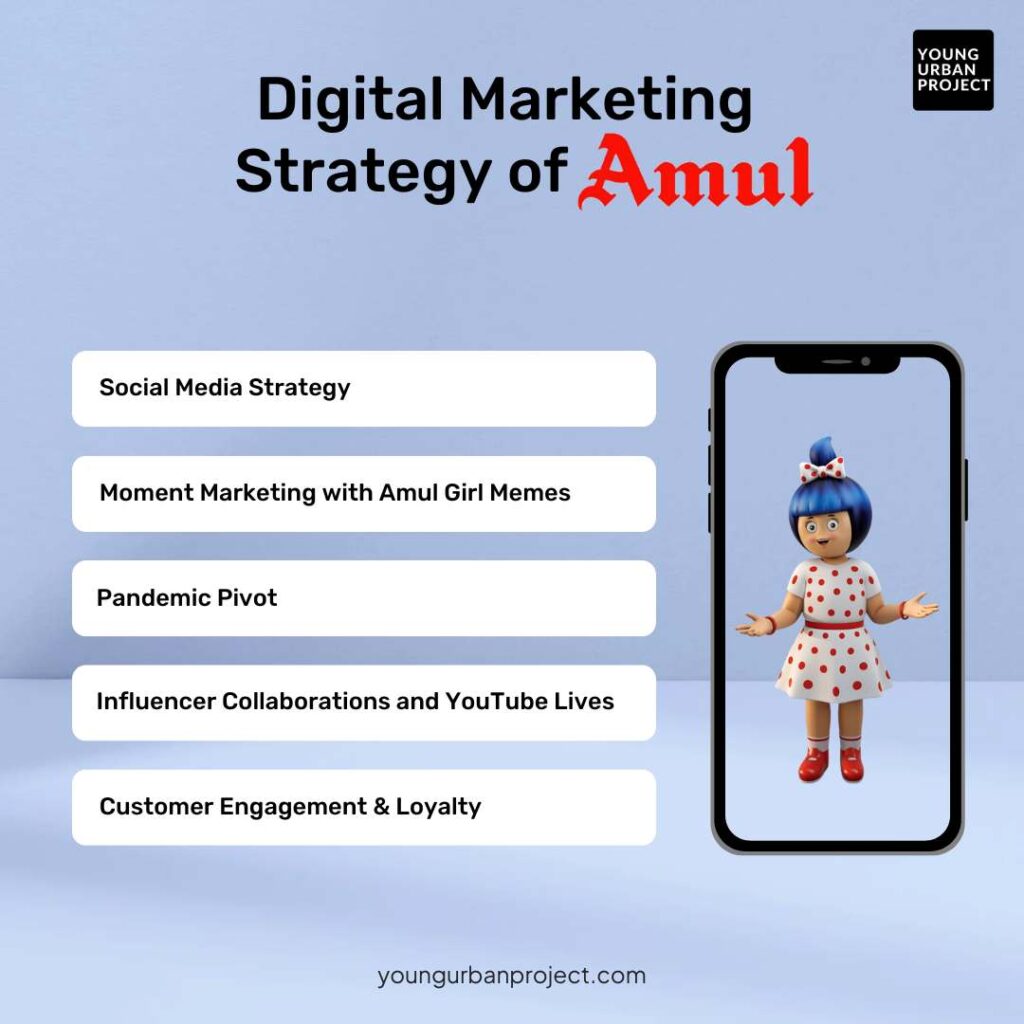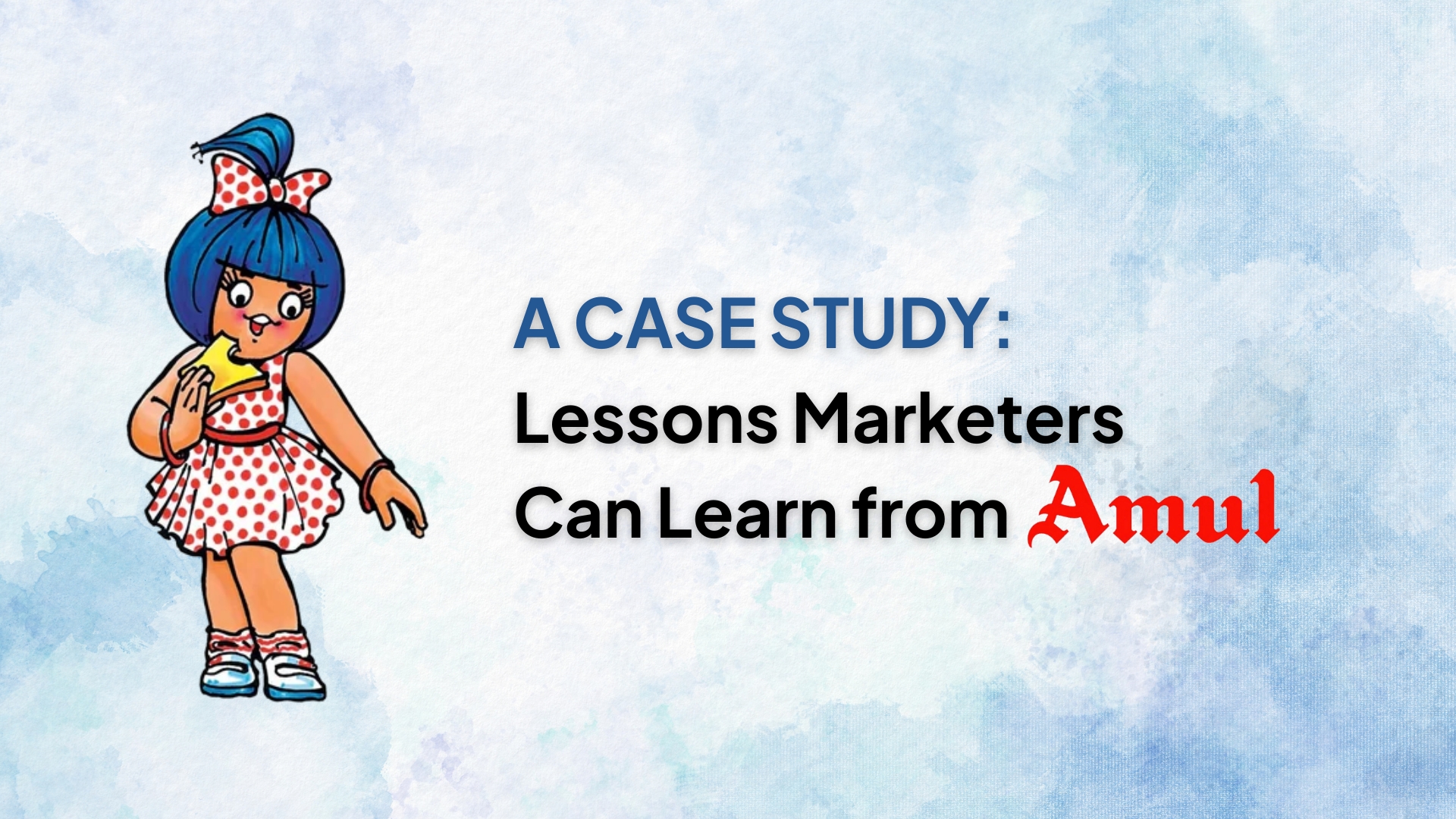Amul is one of the most loved brands in India. But it’s more than just a dairy brand – it’s a movement that changed the lives of millions of farmers. In this Amul case study, we’ll explore how Amul began, the reason behind its success, how its unique business model works, and the smart marketing strategies that made it a household name.
Table of Contents
The Origins of Amul: A Revolution in the Making
Amul began in 1946 in a small town called Anand in Gujarat. Back then, dairy farmers were being badly exploited by middlemen who bought milk at very low prices and sold it for high profits. To fight this, farmers came together and started a cooperative.
Dr. Verghese Kurien joined the movement and helped turn it into something powerful. He introduced new ideas, better technology, and built trust with farmers. This led to the White Revolution – a movement that made India the largest milk producer in the world. Amul was born out of the need for fairness, and it became a symbol of change.
The Amul Model: A Cooperative That Changed India
The Amul model is a three-tier system that connects millions of small dairy farmers directly to the market. It’s run by the Gujarat Co-operative Milk Marketing Federation (GCMMF), and it’s based on one simple idea – give control back to the farmers.
At the village level, farmers pour their milk into collection centers. These are managed by local milk societies. The milk then goes to district unions for processing and finally to state-level federations like GCMMF for marketing and sales.
This model has empowered farmers, given them a steady income, and built a strong network of trust. It also removes middlemen, so profits go straight to the producers. This simple but powerful idea helped change rural India forever.
Amul’s Business Model: Innovation Meets Impact

1. Amul as an Umbrella Brand
Amul functions as a master brand housing over 50 dairy products – from milk and butter to cheese and chocolate. This umbrella branding strategy allows Amul to leverage its reputation for quality across diverse product categories while keeping marketing costs low and brand recognition high.
2. Ownership and Governance
Unlike traditional corporations, Amul is owned by the farmers who supply its milk. The cooperative structure means profits flow back to milk producers rather than distant shareholders. Decision-making happens democratically through elected representatives, with women making up a significant portion of the leadership at the village level.
3. How Amul Makes Money
Amul’s revenue model combines volume with value. By procuring milk from millions of farmers, processing it efficiently, and selling directly to consumers, Amul maintains thin margins but massive scale. The cooperative doesn’t maximize profit but optimizes returns to farmers while keeping prices affordable for consumers.
4. Supply Chain Mastery: From Cow to Consumer
Amul’s supply chain is a marvel of efficiency. The process begins with daily milk collection at village societies, where quality testing happens immediately. Refrigerated vans transport milk to district processing plants. A network of 10,000+ distributors and one million retailers ensures products reach consumers while still fresh, even in remote areas without cold chains.
5. Coordinated Functioning of 3 Levels: Village, District, State
The genius of Amul’s system lies in how these three levels work together. Village societies handle daily collection and payments to farmers. District unions focus on processing, packaging, and capacity building. The state federation (GCMMF) manages marketing, branding, and distribution. This clear division of responsibilities creates both specialization and integration.
Also Read: 11 Great Product Marketing Examples to Inspire Position in the Market
Key Drivers of Amul’s Success
1. The Amul Girl – Iconic, Witty & Timeless
The Amul Girl with her polka-dotted dress has been the face of the brand since 1966. Created by Sylvester daCunha, this cartoon mascot offers witty comments on current events while promoting Amul products. The simplicity of these ads combined with their clever wordplay helps Amul stay relevant across generations without spending huge advertising budgets.
2. Product Innovation & Diversification
Amul started with just butter but now offers over 50 products. The brand regularly introduces new items based on changing consumer needs. From long-shelf-life milk to processed cheese slices to ice cream, Amul has expanded while maintaining its dairy focus. This wide product range helps protect the business from market changes and reach more customers.
3. Efficient and Resilient Supply Chain
Amul collects milk twice daily from 3.6 million farmers across 18,700 villages. This massive operation runs smoothly because of smart planning and technology use. The direct farmer-to-factory model cuts out middlemen and helps control quality. Even during crises like COVID-19, Amul’s supply chain remained operational when many businesses couldn’t.
4. Consistent Quality and Distribution
Amul maintains strict quality standards across all products. The brand uses a wide distribution network of over 10,000 dealers and 1 million retailers to reach consumers in both cities and villages. The cooperative invests in cold storage and transport facilities to keep products fresh. This reliability builds customer loyalty and repeat purchases.
5. Trust and Emotional Branding – “Taste of India”
Amul has positioned itself as more than just a dairy brand – it’s a part of Indian life. The slogan “Taste of India” connects Amul to national identity and pride. By keeping products affordable and available everywhere, Amul created emotional bonds with generations of families. This trust translates to customer loyalty that most brands can only dream of achieving.
Amul’s Marketing & Branding Strategy
1. Product Mix: How Amul Built a Dairy Empire
Amul’s product mix follows a simple rule: start with basic dairy products, then expand into related categories. The brand began with butter, added milk, then moved into cheese, yogurt, and ice cream. Amul also creates products for different segments – from budget options to premium varieties. This careful expansion allows Amul to use its existing production facilities and distribution channels efficiently.
2. Price Strategy: Affordable Yet Profitable
Amul uses a “value-for-money” pricing approach. Products are priced just enough to cover costs and provide fair returns to farmers, but low enough for average families to afford. This strategy helps Amul achieve high sales volumes rather than high profit margins. By keeping prices stable even when market conditions change, Amul builds customer trust.
Also Read: What is Price Mix? Learn How Companies Set Prices
3. Place Strategy: Penetrating Urban and Rural Markets
Amul reaches customers through multiple channels. In cities, Amul products are available in supermarkets, small shops, and through home delivery. In rural areas, Amul works with local shops and village cooperatives. The brand also operates Amul parlors (exclusive brand stores) and has recently expanded to online sales. This flexible distribution strategy ensures products are accessible everywhere.
Also Read: What Is Marketing Mix? The 4 Ps of Marketing
4. Promotion Strategy: From Billboards to Digital
Amul’s advertising is famous for being consistent yet creative. The Amul Girl topical ads have appeared on billboards for over 50 years. On television, simple ads focus on product benefits rather than fancy production. Recently, Amul has embraced social media with timely posts that often go viral. Despite these changes in media, the brand’s straightforward messaging remains the same.
Also Read: What is Promotion Mix?
5. Experiential & Sentimental Marketing (“Amul Doodh Peeta Hai India”)
Amul connects with customers through emotional campaigns that highlight its role in Indian life. The famous “Amul Doodh Peeta Hai India” (India drinks Amul milk) campaign linked the brand to national health and strength. Amul also sponsors sports teams and cultural events that match its wholesome image. Through these activities, Amul positions itself not just as a food brand but as a positive force in society.
Also Read: 20 Digital Marketing Examples to Learn From
Digital Marketing Strategy of Amul

1. Social Media Strategy (Instagram, Facebook, YouTube)
Amul uses social media to connect with younger customers. On Instagram and Facebook, they share the famous Amul Girl cartoons that comment on current events. Their YouTube channel offers product information videos and cooking recipes using Amul products. Unlike many modern brands, Amul keeps its social media simple and product-focused rather than creating complicated campaigns.
2. Moment Marketing with Amul Girl Memes
Amul is a pioneer of “moment marketing” in India. When big news happens – whether it’s cricket matches, movie releases, or political events – Amul quickly creates topical cartoon ads featuring the Amul Girl. These timely ads get shared widely online, giving the brand free publicity. This approach keeps Amul relevant without big advertising budgets.
3. Pandemic Pivot: How Amul Thrived During COVID-19
During lockdowns when many businesses struggled, Amul adapted quickly. They used social media to reassure customers about product availability and safety. Amul increased home delivery options and worked with local authorities to keep supply chains running. They even launched new immunity-boosting products like haldi (turmeric) milk. These smart moves actually helped Amul grow during the pandemic.
4. Influencer Collaborations and YouTube
Amul works with food bloggers and home chefs rather than celebrity influencers. These partnerships focus on showing how Amul products can be used in everyday cooking. During festivals, Amul hosts YouTube live sessions where chefs create special recipes. This practical approach connects better with their target audience than flashy celebrity endorsements.
5. Customer Engagement & Loyalty
Amul builds loyalty through consistent quality rather than points programs or discounts. They engage customers by inviting recipe submissions and running simple contests on social media. The brand also responds to customer feedback about products and addresses complaints quickly. This respectful approach makes customers feel valued without complicated loyalty schemes.

Enroll Now: Digital Marketing Course
Amul’s Target Audience and Market Segments
1. Demographic & Psychographic Targeting
Amul targets a wide audience across age groups and income levels. Their core customers are middle-class families who value nutrition and tradition. Amul appeals to practical buyers who want good quality at fair prices. The brand connects with people who take pride in supporting Indian products and the cooperative movement that helps farmers.
2. B2C: Urban & Rural Households
In cities, Amul focuses on busy families who need convenient yet nutritious food options. They offer small packs for single urban professionals and larger sizes for families. In rural areas, Amul provides basic dairy products that are affordable and have good shelf life despite refrigeration challenges. The brand adjusts packaging and sizes to suit different household needs.
Read More: B2C vs D2C: Key Differences
3. B2B: Retailers, Food Businesses, Hospitality Industry
Beyond selling to end consumers, Amul supplies dairy ingredients to bakeries, restaurants, and food manufacturers. They offer special bulk packaging and consistent quality that commercial kitchens depend on. Amul also works with hotels and catering services, providing branded butter chiplets and cheese portions. This B2B segment creates stable demand for Amul’s products.
Read More: What is B2B and B2C? The Key Differences
How Amul Made Dairy Cool Again
1. Changing Perceptions About Indian Dairy Products
Amul transformed how Indians view local dairy. Before Amul, packaged dairy was often seen as inferior to fresh dairy from local vendors. Through consistent quality and clever marketing, Amul convinced consumers that packaged dairy could be both convenient and trustworthy. They positioned dairy not just as a basic food but as a source of nutrition and enjoyment.
2. Expanding Product Categories (Chocolate, Cheese, Ice Creams)
Amul strategically moved beyond basic milk and butter. They introduced Indians to processed cheese when it was mostly imported. Their ice cream launched at lower prices than foreign brands. Recently, Amul entered the chocolate market, competing with global giants by highlighting their real milk content. Each new category helped make dairy products more exciting to consumers.
3. Launching Regional Variants for Diverse Tastes
Understanding India’s diverse food cultures, Amul creates products for regional tastes. They offer sweeter butter for West India and saltier versions for the South. Amul makes regional sweets like shrikhand for Maharashtra and basundi for Gujarat. Special festival products and seasonal items keep the brand connected to local traditions while maintaining mass appeal.
4. Value-Added Products for Health-Conscious Consumers
As health awareness grows, Amul has introduced products like sugar-free ice cream, probiotic yogurt, and high-protein drinks. Their “Amul Pro” series targets fitness enthusiasts while preserving taste. By balancing tradition with modern health trends, Amul keeps dairy relevant to younger, health-conscious consumers without abandoning their core values of natural goodness.
Revenue, Growth & Global Presence of Amul
1. Turnover and Expansion Highlights
Amul, managed by the Gujarat Cooperative Milk Marketing Federation (GCMMF), has experienced remarkable growth over the past decade. Its turnover surged from ₹8,005 crore in 2009-10 to ₹38,542 crore in 2019-20. By 2023, Amul had reached ₹72,000 crore (around USD 9 billion), making it India’s top FMCG brand and the 8th largest dairy company in the world, according to Amul’s official press release.
In FY 2022-23, Amul reported an impressive 18.5% growth, adding ₹11,000 crore to its topline in just one year. The brand’s upward momentum continues, with a projected revenue of ₹80,000 crore for FY 2023-24. Jayen Mehta, MD of GCMMF, as reported by Exchange4Media, stated that Amul is aiming for a ₹1 lakh crore turnover by 2025.
Amul’s operations span five major verticals:
- Fresh Products – milk, buttermilk, paneer
- Dairy Products – butter, cheese, milk powders, tetra-pak milk
- Frozen Foods – ice cream, frozen snacks, fries
- Commodities – bulk dairy ingredients
- International Business – with exports to over 50 countries
Each category has played a role in Amul’s double-digit growth. Notably, the frozen foods segment alone has grown by over 40% in a recent year, showing how Amul is smartly diversifying while staying true to its dairy roots.
2. Export Strategy – Taking the “Taste of India” Global
Amul exports dairy products to over 50 countries, focusing on markets with large Indian diaspora communities. The Gulf countries, USA, Singapore, and Australia are key export destinations. Amul sells traditional Indian dairy products like ghee and paneer to homesick Indians abroad, while also offering universal products like butter and milk powder. Their export strategy balances authentic Indian flavors with adaptations for international tastes.
3. Challenges in Scaling a Co-op Business
Despite its success, Amul faces unique challenges as a cooperative. Decision-making can be slower than in private companies since changes need broader consensus. Raising capital for expansion is harder without selling shares to outside investors. Balancing fair prices for farmers with affordable products for consumers becomes more complex as the operation grows. Yet Amul’s cooperative model also provides advantages in farmer loyalty and stable milk supply that private competitors can’t match.
Lessons Marketers Can Learn from Amul

1. Consistent Brand Voice Across Decades
For over 50 years, Amul has maintained the same character (the Amul Girl), the same bold typography, and the same witty tone in advertising. This consistency built instant recognition that newer brands struggle to achieve. While many brands chase trends and constantly redesign their image, Amul shows that long-term consistency creates deeper connections with customers.
2. Leveraging Emotion in Advertising
Amul doesn’t just sell dairy products – it sells nostalgia, national pride, and family values. Their advertisements remind Indians of childhood memories and cultural traditions. The brand connects everyday moments like morning tea with their butter, creating emotional associations that go beyond product features. This emotional approach has created customer loyalty that price wars can’t easily break.
3. Product-Market Fit & Regional Customization
Instead of forcing one standard product nationwide, Amul smartly adapts to regional preferences. This flexibility helped Amul succeed where many national and international brands failed in India’s diverse market. They prove that listening to local tastes rather than imposing standardized products creates better customer satisfaction and sales results.
4. Building a Community-Driven Brand
Amul was community-focused before it became a marketing buzzword. The brand’s very structure puts farmers at the center, giving them ownership and voice. This authentic community connection provides Amul with real stories and impact that purely profit-driven companies struggle to match. Modern marketers can learn that genuine community involvement creates deeper brand loyalty than superficial social media campaigns.
FAQs: Amul Case Study
1. What does Amul stand for, and who owns it?
Amul stands for “Anand Milk Union Limited” and is owned by Gujarat’s dairy farmers. The 3.6 million farmer members collectively own and control the brand through their elected representatives in the cooperative structure.
2. What is the Amul model, and how does it work?
The Amul model connects farmers directly to markets through village cooperatives, district processing unions, and a state marketing federation. Farmers deliver milk to village societies, get fair prices, and share profits while professionals handle processing and marketing.
3. What made the White Revolution a success in India?
The White Revolution succeeded because it organized small farmers, created farmer-owned processing facilities, and established efficient milk collection systems. Dr. Kurien’s leadership combined technical knowledge with community organization, transforming India from milk-deficient to the world’s largest producer.
4. Why is the Amul Girl so iconic in Indian advertising?
The Amul Girl comments on current events with clever wordplay and humor while promoting butter. Her consistent appearance since 1966 builds recognition, while her topical messages keep the brand relevant. This affordable, timely advertising approach gives Amul cultural impact beyond its budget.
5. How does Amul use digital marketing to grow its brand today?
Amul shares its topical cartoons on social media where they often go viral. They focus on practical content like recipes and product information rather than flashy campaigns. Amul’s digital approach emphasizes consistent messaging and consumer engagement over marketing gimmicks.
6. What can marketers learn from Amul’s branding strategy?
Marketers should value consistency over constant rebranding, connect products to cultural moments, adapt to regional preferences, and build authentic community relationships. Amul shows that long-term thinking and genuine values create stronger brands than chasing short-term trends.

